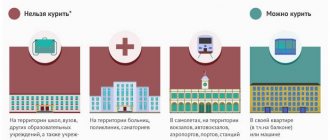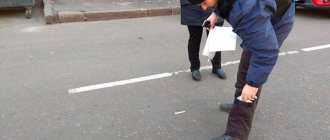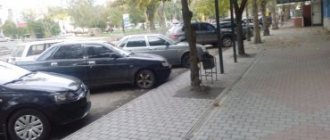Since January 2021, parking commercial vehicles in the yard is strictly prohibited, and violators will face a fine of one to five thousand rubles. So far, the innovation is valid only in Moscow, St. Petersburg and Sevastopol, where the most difficult situation occurs. Below we will consider what the law and traffic regulations say about this, what punishment awaits violators and how to act for residents of houses who have witnessed such arbitrariness.
The essence of innovation
From the beginning of 2020, rules regarding parking spaces for vehicles registered to companies and entrepreneurs will come into force. Information can be found in the Order of the Ministry of Transport of the Russian Federation dated May 17, 2021. It states that the innovation concerns only a few localities of national importance, namely the capital, St. Petersburg and Sevastopol.
The ban applies to vehicles that meet the following criteria:
owner - individual entrepreneur or company.
transportation of goods or passengers on the basis of a contract.
moving within three cities or returning to them from a flight.
The law banning the parking of commercial vehicles in the courtyards of residential buildings was a response to numerous complaints from people, representatives of utility and rescue services. Drivers of such vehicles occupy empty seats or position their vehicles in such a way that they do not allow residents of nearby buildings or special vehicles (firefighters, ambulances, etc.) to pass.
The idea of introducing a ban appeared back in 2021. During this time, many local bans relating to certain sites were developed. From the beginning of 2020, the rule applies to all courtyards of residential buildings, and the task of municipal authorities is to ensure compliance with the innovation. The first step was taken by residents of the capital, who provided parking outside the city. Interestingly, the ban applies to all types of commercial vehicles. This category includes trucks, taxis, buses and other vehicles. Against this background, a number of questions arise. For example, if a person is engaged in private transportation, does his car belong to the taxi category?
What the traffic rules say
When considering the issue of parking near apartment buildings, it is important to remember the traffic rules. It states here that in residential areas it is prohibited:
1. “Through” movement. We are talking about driving through a yard in order to reach another section of the road and reduce the total distance. In this case, the driver automatically violates traffic rules.
2. Parking with the engine running for more than five minutes. The rule is determined by concern for people from the perspective of the negative impact of exhaust gases on health. The downside is that it is almost impossible to hold a car driver accountable under this rule. This is especially true if it happens in winter, when it’s frosty outside, and the driver is forced to warm up the car.
3. Driving lessons. If the “U” sign is installed on the vehicle, it is prohibited to move through residential yards for educational purposes.
4. Turning around and moving in reverse. The exception is cases when the driver has no other choice, for example, he has reached a dead end.
In addition, according to traffic rules, trucks cannot be parked in the courtyards of residential buildings. Stopping is allowed only if the weight of the car is no more than 3.5 tons, and the car itself is parked on a special platform.
In practice, truck drivers rarely enter yards. The following cases are exceptions:
1. One of the relatives or friends lives in the house.
2. A person cannot find the right road.
3. The truck driver plans to spend the night and is looking for a quiet place.
Regardless of the reason, the driver of such a vehicle is breaking the law. In addition, in the residential sector there are strict rules even for passenger cars:
You cannot park on the sidewalk, lawn, sports ground or other area that is not intended for this purpose.
It is prohibited to park a vehicle, thereby blocking the movement of other cars.
Parking of vehicles under balconies or windows is excluded (this is allowed at a distance of 10 m or more).
In new houses, construction companies take into account legal requirements and provide places where drivers can park their cars. But this possibility does not apply to commercial vehicles.
General rules
Traffic rules (TRAF) are a fundamental legislative document that regulates the actions of road users in all situations. Article No. 17 of this code is devoted to traffic and parking in a residential area. This includes territories defined by special signs 5.21 and 5.22, indicating the beginning and end of the residential zone. In a general sense, a residential area is the adjacent territory of an apartment building or several residential buildings. Most often, you can see signs 5.21 and 5.22 in residential areas of settlements, where there are many residential apartment buildings and few infrastructure facilities. Special rules apply in residential areas:
- Pedestrians can move both on sidewalks and on the roadway. The main thing is not to interfere with moving traffic.
- The maximum speed is limited to 20 km/h. This is due to the fact that there are many children, elderly people, and pets in the area. This speed allows the car to brake in time if necessary and not cause harm to the life and health of a pedestrian.
- Pedestrians have priority when moving, that is, cars are required to let them through and not interfere.
How government agencies solve the problem
The task of the state is not only to prohibit, but also to create conditions for the possibility of complying with regulations. Today, places are being actively created that have appropriate markings and are intended for parking trucks. They are marked with a special sign with the image of a truck in blue. At the end of 2017, transport authorities developed a law that obliges them to provide parking for trucks returning from a trip. This applies to Moscow, St. Petersburg and Sevastopol. The requirements for such places can be easily found in the Department Order issued in 2021 (mentioned above). A special feature of parking areas is their large capacity. As a rule, they have the following parameters:
length - 14-22 m
width - 3.5-5 m
departure - 5.5-12 m
Due to their size, such objects are built with a lot of “creaking” and, as a rule, are located outside the city. In addition, in the above order you can find the requirements regarding such parking:
1. Mandatory lighting taking into account the requirements of SP and SNiP.
2. Availability of technical means for organizing traffic. Compliance with current SanPiN requirements.
3. Availability of road signs and markings. Suitable road surface.
4. Fulfillment of other requirements.
According to the new law, the arrangement of such parking spaces in public areas within areas built up with multi-storey buildings is excluded. At the same time, the previous Order of the Ministry of Transport of the Russian Federation dated 2016 loses its force.
Areas for heavy trucks
Russian legislation prohibits parking of large vehicles near a house outside of special areas. Trucks must be parked in areas marked with a “Parking” sign with additional signs or an image of a truck directly on a blue background. Such sites are characterized by large parking spaces:
- length – from 14 to 22 m;
- width – from 3.5 to 5 m;
- passage width – from 5.5 to 12 m (depending on the established procedure for entry and exit).
What to do if a commercial vehicle is parked in the yard
Residents of houses often face the arbitrariness of drivers who use the nearest yard as a parking lot. In such cases, the task of identifying violations falls on the residents of the houses, who must report the problem. The algorithm of actions is as follows:
1. Collect information about the offending driver. If a person lives in a nearby house, check his name.
2. Write down the vehicle number.
3. Fill out an application to the traffic police department. In it, write down all the available data and describe the situation, for example, parking of commercial vehicles in the wrong place.
Please remember that the application refers to official documents. Representatives of the authorities are obliged to respond to the appeal and consider it in the prescribed manner. Subsequently, traffic police representatives respond to the complaint or give a written response. If a request is ignored, a person has the right to contact a higher authority.
Traffic regulations and parking in a residential area
Trucks don't just drive into residential areas. There are several common reasons:
- The driver or one of his relatives lives in this zone.
- The driver is not local and simply got lost, despite many warning and prohibition signs.
- A truck driver wants to spend the night in peace and is looking for a suitable quiet place to sleep.
However, whatever the reason for entering a prohibited area, it is in any case a traffic offense. In residential areas there are strict parking requirements, even for passenger cars:
- In accordance with the traffic rules, parking in a residential area is prohibited on lawns, sidewalks, children's or sports grounds, as well as other areas not intended for this purpose.
- You cannot park a vehicle blocking the exit for other vehicles.
- You cannot park cars under windows or balconies of houses. Traffic rules require strict adherence to distance: a minimum of 10 m for a small parking lot (capacity up to 10 cars).
Healthy! In recent years, a law has been in force in Russia obliging developers to provide for proper parking during the construction phase of a building. Therefore, in new houses there are much fewer problems with parking a car.
Responsibility for violation
There were no fines for parking commercial vehicles in the yard until 2021, which led to impunity on the part of violators. Residents of the houses saw trucks and other cargo equipment in the yard, complained to the traffic police, but did not achieve results. Employees of this body came to the call, but they could only fine you for illegal parking (if there was one). The amount of financial punishment is from 1500 rubles, and for settlements at the federal level from 3000 rubles. Since the beginning of January 2020, a fine for “night” parking has appeared. It allows you to punish drivers of gazelles, taxis, trucks and other commercial vehicles who leave their car in the yard. The rule also applies to cars operating in car sharing. However, the mechanism for applying punishment is not yet clear.
Where to complain about illegal parking at the entrance?
This depends on the type of offense. If it falls under the articles of traffic rules, then the responsibility for registration lies with the traffic police officers, to whom the application (message) must be sent. In other cases, these may be representatives of other departments of the Ministry of Internal Affairs, regional authorities, and municipalities.
Some entities use comprehensive approaches to filing a complaint. For example, Moscow offers special applications and other online methods for reporting parking violations.
Results
Thus, from the beginning of 2021, entrepreneurs, taxi workers, drivers of trucks and other commercial equipment cannot abandon vehicles in the courtyards of residential buildings. You also cannot leave the vehicle if the driver lives in a nearby house. Otherwise, the violator is warned and fined in accordance with the new law. For many people, this innovation was a “breath of fresh air.” All that remains is to understand the mechanism for implementing the law, because there are no clear recommendations on the imposition and collection of fines yet.
Appeal
Appealing fines follows the general scheme that we described here. The application is submitted at the place where the incident was recorded to the head of the local traffic police or to the district court. Before starting a dispute, you can contact a car lawyer on our website. For free!
It is legal to have off-street parking. It is impossible to completely deprive motorists of the opportunity to leave their vehicles on the street. However, the rules for parking equipment are quite strict - the rights of other categories of persons cannot be infringed.
A reasonable approach is a compromise between motorists and other residents. In such courtyards there is always peace and the opportunity to resolve issues. If such an idyll is unattainable, then now you know how and for what you can be held accountable, and what, on the contrary, is the legal right of car owners.










